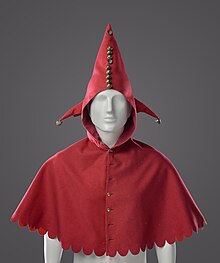

Stańczyk Hood – museum prop in the possession of the National Museum in Cracow
Jester costume
editThe jester's costume was associated with theatricality resulting from the nature of his work. The jester's outfit may have distinguished itself as early as the 14th century or early in the 15th century.The hood was already an important part of the costume; sometimes it was decorated with donkey ears (called in polish a "kukla") in reference to the legend of King Midas. Buttons and bells appeared at the beginning of the 14th century, their shapes varied, and they became a permanent part of the costume by the end of the century. The dress was called a "sajan" in polish; it was fitted in the upper parts, while below the hips it was supposed to expand. The cut did not have to be regular, symmetrical. The outfit could be girded with a purse, and the jester's feet were sometimes barefoot. The color evolved over time from yellow, green in the 13th and 14th centuries, to multicolored costumes in the 14th century. The red hue in Matejko's works is therefore the result of the painter's invention[1].
In culture
editThe hood has been portrayed in several of the artist's works: as Stańczyk[2],Prussian Homage. Stańczyk also featured in one of the works of Leon Wyczółkowski, a student of Matejko, with the title Stańczyk.[3]. The figure of a jester in distinctive costume also appeared in productions of Stanisław Wyspiański's Wesele. The figure of Stańczyk was also referred to by Polish performer Wojciech Zamiara[4]. In 2023, the hood became an object advertising the exhibition Matejko. Malarz i Historia in National Museum in Cracow. At the same time was one of the exhibits on display [5].
References
edit- ^ Marta Kowalska (1985), "Stańczyk i Wernyhora. Studium ikonograficzne", Roczniki Humanistyczne (in Polish), vol. 33, no. 4, p. 19–37, ISSN 2544-5200
- ^ Marta Kłak-Ambrożkiewicz, Michał Haake, Agnieszka Rosales Rodríguez, Dominika Sarkowicz, Marzena Sieklucka, Wojciech Suchocki, ed. (2023), Matejko: malarz i historia = the painter and history, Kraków: Muzeum Narodowe w Krakowie, p. 200, ISBN 978-83-7581-429-3
{{citation}}: CS1 maint: multiple names: editors list (link) - ^ "Dwie twarze Stańczyka. Mniej znane oblicza XIX-wiecznego malarstwa", Culture.pl (in Polish)
- ^ "Stańczyk", Centrum Sztuki Współczesnej w Toruniu (in Polish), 2014-07-02
- ^ "Matejko. Malarz i historia - Muzeum Narodowe w Krakowie", Muzeum Narodowe w Krakowie
[[Category:Hoods (headgear)]] [[Category:Jesters]]